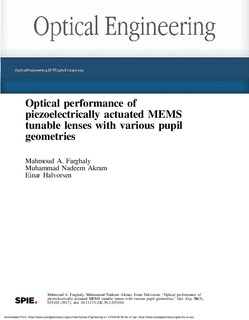| dc.contributor.author | Abdelmeguid, Mahmoud Ahmed Farghaly | |
| dc.contributor.author | Akram, Muhammad Nadeem | |
| dc.contributor.author | Halvorsen, Einar | |
| dc.date.accessioned | 2018-01-25T10:20:00Z | |
| dc.date.available | 2018-01-25T10:20:00Z | |
| dc.date.created | 2017-11-02T08:42:59Z | |
| dc.date.issued | 2017 | |
| dc.identifier.citation | Optical Engineering. 2017, 56 (3), 035104-1 - 035104-10 | nb_NO |
| dc.identifier.issn | 0091-3286 | |
| dc.identifier.uri | http://hdl.handle.net/11250/2479621 | |
| dc.description.abstract | Abstract. A square geometry for the diaphragm of microelectromechanical systems (MEMS) tunable lenses with circular pupils is often used. This square diaphragm introduces aberrations that would not be present for a circular diaphragm and the question arises of whether it could be advantageous to also consider other than circular geometries for the pupil. To investigate this question, we have extended a previously established modeling framework for piezoelectrically actuated MEMS tunable lenses to devices with general polygonalshaped pupils. It models the static optoelectromechanical coupling for symmetric configurations based on laminated-plate theory, linear piezoelectricity, and ray tracing. The framework helps to find geometrical parameters that give a diffraction-limited tunable lens with a minimum F-number. The tunable lens’ optical performance and its focusing capability, alone and in combination with a fixed lens, were calculated in terms of object distances and actuation voltages. Using the modeling framework, we show that the modulation transfer function of the tunable lens and the fixed lens combination remains the same up to a _10- deg field of view after voltage adjustment to refocus on near objects. In addition, we found that pupil masking of the tunable lens can provide a beneficial tradeoff between the lens dioptric power and its RMS wavefront error. | nb_NO |
| dc.language.iso | eng | nb_NO |
| dc.rights | Navngivelse 3.0 Internasjonal | * |
| dc.rights.uri | http://creativecommons.org/licenses/by/4.0/deed.no | * |
| dc.title | Optical performance of piezoelectrically actuated MEMS tunable lenses with various pupil geometries | nb_NO |
| dc.type | Journal article | nb_NO |
| dc.type | Peer reviewed | nb_NO |
| dc.description.version | publishedVersion | nb_NO |
| dc.rights.holder | © The Authors | nb_NO |
| dc.source.pagenumber | 035104-1 - 035104-10 | nb_NO |
| dc.source.volume | 56 | nb_NO |
| dc.source.journal | Optical Engineering: The Journal of SPIE | nb_NO |
| dc.source.issue | 3 | nb_NO |
| dc.identifier.doi | 10.1117/1.OE.56.3.035104 | |
| dc.identifier.cristin | 1510103 | |
| dc.relation.project | Norges forskningsråd: 235210 | nb_NO |
| cristin.unitcode | 222,58,4,0 | |
| cristin.unitname | Institutt for mikrosystemer | |
| cristin.ispublished | true | |
| cristin.fulltext | original | |
| cristin.qualitycode | 1 | |

